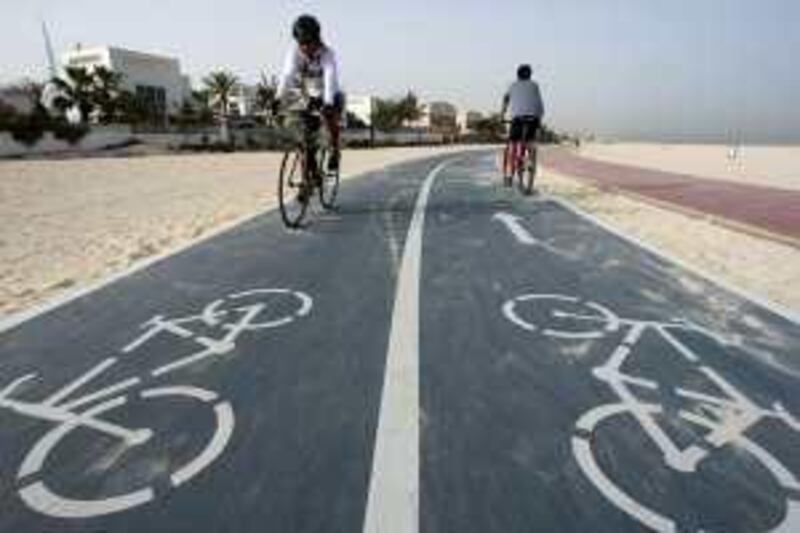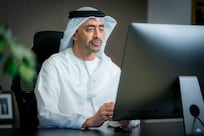DUBAI // Tempted by 900km of bicycle lanes, a large number of residents will be pedalling around the city within the next 10 years, dodging obesity and heart disease and bringing relief to clogged roads. Or so the authorities hope. "Our vision is to make Dubai an international cycling centre and offer a distinctive cycling experience to residents and tourists," said Nasser Bu Shahab, the head of strategic planning at the Road Transport Authority, who presented the cycling plan at a recent physical activity forum hosted by Dubai Sports Council. "We have learned from schemes in cities such as Paris and London that cycle paths can have a dramatic effect on reducing traffic and increasing the physical health and well-being of the population." The plan has been three years in the making, drawing on best practice from around the world, and was recently given fresh urgency by a sports council study that found 66 per cent of Dubai residents perform no physical activity. The scheme is also designed to promote tourism by creating a "themed" cycling environment, with trails to show off cultural and heritage sights such as souks, dhow harbours and museums. Mr Shahab said the project would have three stages, focusing initially on the beachfront and creekside, then the Central Business Districts, and finally the eastern suburbs, with a target completion date of 2020. "Alongside construction of the cycle paths we will be promoting bicycle use and collaborating with schools on road safety," he said. "A recent study we conducted revealed that 68 per cent of bicycle use was for commuting but that 95 per cent of bike users had no car available to them. We want to promote cycling as a viable alternative for car owners, especially for short journeys. Providing infrastructure and making cycling a pleasant experience will help establish a cycling culture." As well as creating cycle lanes on existing roads and public spaces, the authorities will issue a directive requiring all future developments to include cycle paths; every home or workplace in the city should be within a kilometre of a cycle path. The routes will be a mixture of marked lanes on roads and separate cycleways running alongside roads and through public open spaces. The first stage of the project, due to be completed by mid-2010, will extend the current cycle paths on Jumeirah Beach Road and Jumeirah Open Beach to connect the Burj al Arab with Dubai Creek. This route will form the Gulf Coast Trail, the first of the themed routes, with signboards giving information about the surrounding area. Another existing network, running alongside Mumzar Park, will be extended to the Deira creekside. The second phase will see the network expand along the creek to link the traditional business and residential districts of Bur Dubai and Deira, as well as south to Jebel Ali. Cycle lanes will be created along the metro route on Sheikh Zayed Road. The final phase will bring the outlying suburbs around Emirates Road and Al Hibab Road into the network, and provide a route around the Palm Jebel Ali development. Wolfgang Hohmann, 38, the owner of Wolfi's bike shop and a key figure in promoting cycling in the UAE, welcomed the proposals but said development of a cycle lane network must be accompanied by a cycling awareness campaign. "The plans are very positive for cyclists in the UAE," he said. "There is a chance to create something very special and for cycling to play a key role in getting people in Dubai more active and health conscious. The statistics for heart disease and child obesity are alarming. I see it as the greatest challenge facing the city. "As well as providing infrastructure there is a need to establish the rights of cyclists. Currently it can be dangerous to cycle in the city, especially when crossing junctions. Dubai's code of conduct even states that cyclists can be fined for using the roads. These factors need to be addressed if a cycling culture is to be established. "There also needs to be a cycling proficiency programme in schools, like they have in Europe. Accompanying this should be a public awareness campaign for drivers to respect cyclists and raise the social perception of the risks." The promotion of cycling is part of a range of measures being implemented to encourage a more active lifestyle among Dubai's residents. This is being done along the lines of the Agita project in São Paulo, which focuses on everyday exercise rather than sport and has produced a 70 per cent increase in physical activity in the Brazilian city since it began in 1999. One of the key messages in the Agita campaign is that "physical activity is medicine" and a mere 30 minutes of activity a day can boost physical fitness, mental sharpness and will in the long term increase productivity, reduce stress and save significant sums in healthcare costs. Dr Sandra Mahecha, coordinator of the São Paulo campaign, said it could be applied effectively in Dubai. "It will have to be adapted to the distinct culture and customs of Dubai but there is no reason why it couldn't be very effective. Indeed, applying the lessons learned in São Paulo, similar results could be achieved within six years." Salah al Makhdoum, head of the parks division at Dubai Municipality, said promoting cycling was at the heart of the city's goal to increase levels of sport and exercise. "We have worked with developers to ensure all residential areas are constructed with open space for exercise and sport. We have specified that 45 per cent of residential areas should be green spaces and available for physical activity. We are also creating 'school parks' to encourage schools to increase levels of physical education." For visitors to the city there will be facilities such as bicycle hire, secured cycle shelters and a central servicing centre to encourage them to explore the city on two wheels instead of relying on taxis. tbrooks@thenational.ae
Cycle plan on track for Dubai
A large number of residents will be pedalling around Dubai within the next 10 years, authorities hope.

Editor's picks
More from the national





